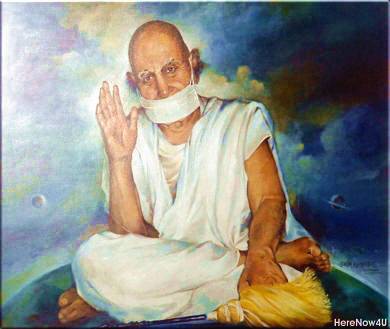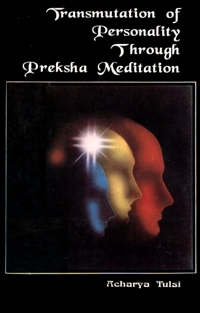
If you really wish to practise equanimity,
Practise self-contemplation above all!
Between meditation and study, there's a bridge,
Call it anupreksha, or discretion;
It's derived from the word meaning 'inter-meditation';
He who practises it, finds immortal Truth.
Whether a meditator or a scholar or a scientist,
The path of anupreksha is open to all!
After perceiving a fact, contemplate upon it well!
What you discover is the fruit of anupreksha!
When a known fact is subjected to personal reflection,
A new truth is born; that is applied anupreksha!
Among the five kinds of study mentioned in the Agamas,
Reading, Questioning, Intelligent Recounting, Anuperksha, Discourse;
Anupreksha is the most original and thriving.
Without it, the discourse is for ever wanting!
Anupreksha or feeling alone provides a solid foundation;
Hear it described, to reap great spiritual satisfaction!
It is clear that the development of equanimity is necessary for inner happiness. But the mind's problem is not resolved. After all,how is one to develop equanimity?
For the development of equanimity, it is necessary to practiseanupreksha . Preksha and anupreksha constitute a pair. In the system of preksha dhyana, thought commands the same importance as the act of observation. Anupreksha is a thought-induced, suggestive, process. Thought is very necessary for a clear comprehension of the essential religious elements. It is called contemplation or reflection. The essentials are known through contemplation. In the process of knowing these, arise occasions of like and dislike, of attachment and aversion. Unless one is free from like and dislike, meditation can pose a danger. In avoiding like and dislike, contemplation on the 'transitoriness' and 'uncertainty' of life, can be very helpful. That is why it has been called inter-meditation. It is a process, which takes place between two meditations. From this point of view, contemplation (anupreksha) serves as a bridge between self-study and meditation.
Anupreksha means argument or thought. Wherever there is thought, there is conflict. Where there is conflict, there is suffering. Conflict leads to sorrow, and sorrow leads to conflict. In this situation, how can like and dislike be obviated while practising anupreksha?
Thought has two forms - dialectical and supra-rational. The feelings of preference and aversion cannot be separated from dialectical thought. However, thought, which transcends reason, is free from any feelings of like and dislike. A sadhak practising meditation experiences pleasant and unpleasant sensations. If he cannot find a way out of these, he is lost in like and dislike. However, by practising anupreksha, by taking recourse to thought and suggestion, a transformation of instincts inevitably takes place. From the point of view of character-transformation, the practice of anupreksha is more important than that of preksha.
Thinking and experiencing are two different things. Anupreksha is allied to thought, and preksha to experiencing. Anupreksha is verbal. So is japa. Are japa and anupreksha one and the same thing?
Anupreksha is something not merely verbal. Continued reflection can lead to direct realisation. The technique of japa is different; here, the sentence, "I bow to the Enlightened", is repeated time and again. The iteration of words sets going sound-vibrations, which promote both mental integration and peace. However, the mere iteration of words without mindfulness does not increase the length of the sound waves, and therefore concentration does not become perfect. Such a japa is not very productive. But if after pronouncing a word, one is totally immersed in it's meaning, without the interruption of another thought, if this state of total and choiceless concentration continues for half a minute, one then experiences indescribable bliss. Whatever verse is recited or dwelt upon, to wholly merge one's consciousness, mind, feeling and experience in it, is the process of integrated or mindful sadhana.
The practice of japa produces sound vibrations. Does benefit to the sadhak accrue from this or is it the union of japa with bhavana (i.e. repeated practice of principles) that is really productive?
The sound waves have their limited utility. But, combined with bhavana (repeated practice of certain principles) their utility increases manifold. Certain drugs are naturally beneficial, but when these are treated and infused with other substances, their potency increases still further. It is the virtue of myrobalan to effect a purgation, but myrobalan treated with certain medicinal herbs is much more beneficial than the common preparation. Similarly, when the sound vibrations of japa are combined with bhavana, these propel a man in the direction of self-realisation. In the absence of bhavana, no spiritual rites can be fully consummated.
Vipassana is a system of sadhana. It takes a man towards a state of non-conceptualisation or nothingness. This is also a process. But in our view this is not the only process. If to be in a state which transcends thought is sadhana, to think is sadhana, too. The combination of these two makes for wholeness. This is the new concept of the Jain meditation system. According to it, the greater the reflection or contemplation of a received fact, the more wholesome is the consummation.
Once a guru taught a dull-witted pupil of his the lesson of equanimity. There was little room for an elaborate discussion or understanding. So the guru got him to memorise two proverbs, 'Ma rush', 'Ma tush' ('No anger!' 'No gratification',) which meant that under no circumstances should a man entertain anger or seek gratification. After a short while, the pupil forgot the words taught him by his master, and instead iterated 'mash tush, mash tush'. Contemplating upon these words, he set out for seeking alms. He stood before the residence of a householder. The housewife was washing black grams. The Sanskrit word 'mash' means black grams, 'tush' means the husks.
The monk asked the housewife, "Sister, what is it that you are doing?" The housewife said - "Muni Sri! I'm separating the beans from the husks." On hearing this, the monk's eyes sparkled. He exclaimed, "I've got it! Just as the beans are different from the husks, similarly, the soul is different from the body!" The understanding of and continued reflection upon this distinction turned the monk introversive. In the state of introversion, he experienced a heightening of consciousness and attained transcendental knowledge. In the holy trinity of reflection, contemplation and absorption alone is this highest realisation possible.
What are the starting and the culminating points of a sadhak's unique pilgrimage in his search for truth?
The starting point of the search for truth is listening and the ultimate is fulfilment. In between there are eight more stages in the following order:
In this order, one begins to know what is good or bad at stage 4, and the path becomes clear for the discovery of new truths. Here, too, the practice of anupreksha proves most useful. In Uttaradhyana are mentioned five kinds of study, the fourth of which is anupreksha. Before it come, reading, questioning, and intelligent recounting. Only after anupreksha, comes discourse. Generally, every sadhak tends to assume the role of a religious speaker. However, according to a prominent tradition, only he has the right to discourse, who practises anupreksha. Through continual practice of anupreksha, one's comprehension of the essential meaning becomes so sharp and clear that words grow secondary, and the contemplator embodies all meaning in himself. From this angle, anupreksha or feeling becomes a solid basis for the evolution of a state of complete identification.
- Listening
- Knowledge
- Science
- Abstinence
- Penance
- Control
- Steadfastness
- Purification
- Non-Action
- Realisation
 Acharya Tulsi
Acharya Tulsi
